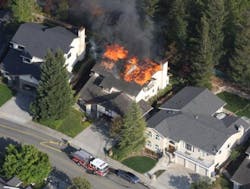Firefighting, Firefighter Safety and the Structural Anatomy of Buildingsonfire
If you don't fully understand how a building truly performs or reacts under fire conditions and the variables that can influence its stability and degradation, movement of fire and products of combustion and the resource requirements for fire suppression in terms of staffing, apparatus and required fire flows, then you will be functioning and operating in a reactionary manner. This places higher risk to your personnel and lessens the likelihood for effective, efficient and safe operations. You're just not doing your job effectively and you're at RISK. These risks can equate into insurmountable operational challenges and could lead to adverse incident outcomes. Someone could get hurt, someone could die, it's that simple, it's that obvious.
The axiom of Building Knowledge = Firefighter Safety (Naum, 2008) continues to form the basis for effective operations, for it's the knowledge of the building and it's anatomy that defines the level of operational safety and incident success share by all personnel and operating companies at the incident. Without understanding the building-occupancy relationships and integrating; construction, occupancies, fire dynamics and fire behavior, risk, analysis, the art and science of firefighting, safety conscious work environment concepts and effective and well-informed incident command management, company level supervision and task level competencies…You are derelict and negligent and “not "everyone may be going home". Our current generation of buildings, construction and occupancies are not as predictable as past conventional construction; risk assessment, strategies and tactics must change to address these new rules of structural fire engagement. There is a need to gain the building construction knowledge and insights and to change and adjust operating profiles in order to safe guard companies, personnel and team compositions. It's all about understanding the building-occupancy relationships and the art and science of firefighting, Building Knowledge = Firefighter Safety that’s what we’ll share here on the Firehouse.com blog Structural Anatomy of Buildingsonfire

Christopher J. Naum
CHRISTOPHER J. NAUM, SFPE a Firehouse® contributing editor, is a 40-year fire service veteran and a national instructor, author, lecturer and fire officer. He is an authority on building construction issues affecting the fire and emergency services and a former fire command officer, architect and fire protection engineer. Naum is a technical consultant and reviewer to the NIOSH firefighter fatality investigation and prevention program, an NFFF Firefighter Safety Advocate and formally served on the Board of Directors of the ISFSI and the IAFC Safety, Health & Survival section and faculty at the National Fire Academy. He was the 1987 ISFSI George D. Post National Fire Instructor Award recipient. Naum is the executive producer of Buildingsonfire.com and FiregroundLeadership.com, sites dedicated to building construction, adaptive fire command and firefighter safety.






